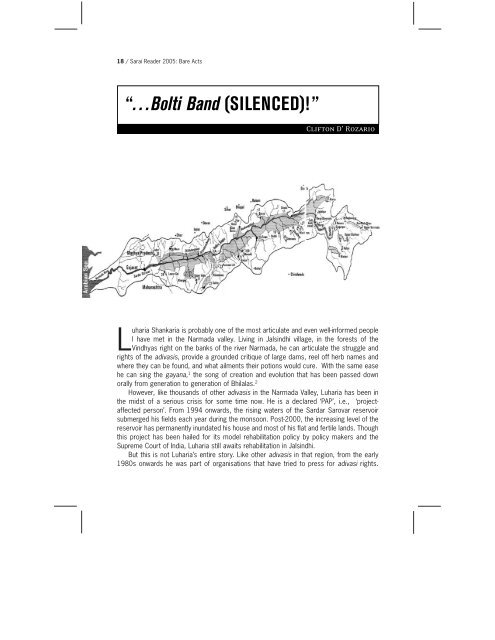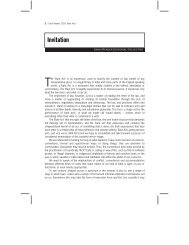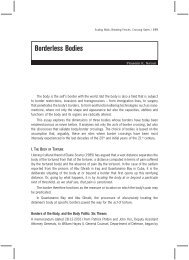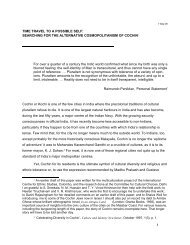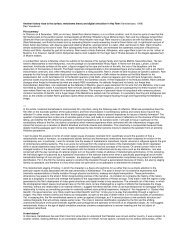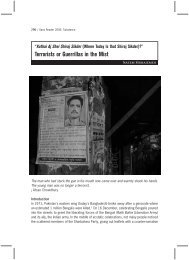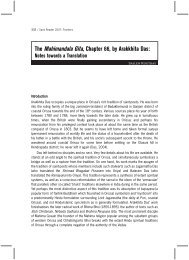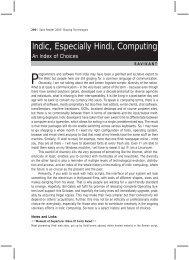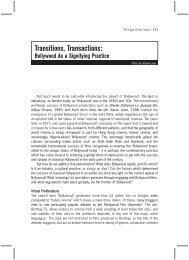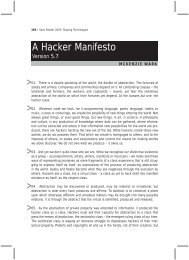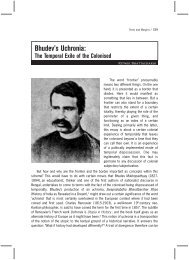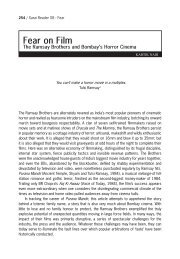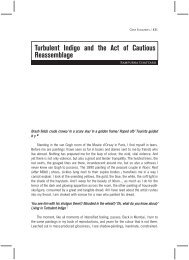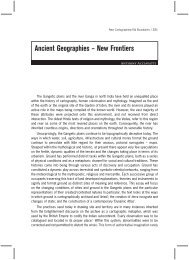“…Bolti Band (SILENCED)!” - Sarai
“…Bolti Band (SILENCED)!” - Sarai
“…Bolti Band (SILENCED)!” - Sarai
You also want an ePaper? Increase the reach of your titles
YUMPU automatically turns print PDFs into web optimized ePapers that Google loves.
18 / <strong>Sarai</strong> Reader 2005: Bare Acts<br />
<strong>“…Bolti</strong> <strong>Band</strong> (<strong>SILENCED</strong>)!<strong>”</strong><br />
Clifton D’ Rozario<br />
Luharia Shankaria is probably one of the most articulate and even well-informed people<br />
I have met in the Narmada valley. Living in Jalsindhi village, in the forests of the<br />
Vindhyas right on the banks of the river Narmada, he can articulate the struggle and<br />
rights of the adivasis, provide a grounded critique of large dams, reel off herb names and<br />
where they can be found, and what ailments their potions would cure. With the same ease<br />
he can sing the gayana, 1 the song of creation and evolution that has been passed down<br />
orally from generation to generation of Bhilalas. 2<br />
However, like thousands of other adivasis in the Narmada Valley, Luharia has been in<br />
the midst of a serious crisis for some time now. He is a declared ‘PAP’, i.e., ‘projectaffected<br />
person’. From 1994 onwards, the rising waters of the Sardar Sarovar reservoir<br />
submerged his fields each year during the monsoon. Post-2000, the increasing level of the<br />
reservoir has permanently inundated his house and most of his flat and fertile lands. Though<br />
this project has been hailed for its model rehabilitation policy by policy makers and the<br />
Supreme Court of India, Luharia still awaits rehabilitation in Jalsindhi.<br />
But this is not Luharia’s entire story. Like other adivasis in that region, from the early<br />
1980s onwards he was part of organisations that have tried to press for adivasi rights.
Arguments / 19<br />
Initially it was the Khedat Mazdoor Chetna Sangath that organised adivasis to demand<br />
access to forest resources denied to them, to protest against and prevent exploitation of<br />
adivasis by the Forest Department, etc. Thereafter, the Sardar Sarovar project emerged<br />
from the dusty papers of developmental projects, and suddenly there was another<br />
adversary. Adivasis like Luharia and other farmers from the plains upstream organised<br />
themselves under the banner of the Narmada Bachao Andolan (NBA) to raise fundamental<br />
questions about the efficacy of large dams, rights of project-affected people, the state’s<br />
rehabilitation policy, and so on. Also raised were the issues of adivasis’ natural rights to<br />
their ancestral lands, and the cultural losses that would be an inevitable consequence of<br />
dam-induced displacement.<br />
After years of dharnas (sit-in protests), deliberations with the state, satyagrahas and so<br />
on, the NBA, in a move to augment its other strategies, decided to approach the Supreme<br />
Court – the ultimate (at least officially) national arbitrator of justice – with the Writ Petition<br />
No. 319 of 1994, filed in May 1994. The court stayed the construction of the dam for<br />
almost five years. The matter was finally disposed on 18 October 2000, with the<br />
construction of the dam being permitted subject, to fulfilment rehabilitation preconditions,<br />
amongst others. Despite this – at least in the opinion of Luharia and others similarly<br />
affected due to the judgment – rehabilitation is still awaited.<br />
Continuing to hope that the Supreme Court would provide justice, the NBA filed Writ<br />
Petition No. 328 of 2002, in which the court passed an order stating that every individual<br />
oustee was free to approach the court with their grievance after they had exhausted the<br />
other official avenues. Today, in early 2005, Luharia still awaits rehabilitation.<br />
This essay is not an attempt to critique of the efficacy of the Sardar Sarovar dam, nor<br />
is it in any way an attempt to valorise the NBA or its strategies. There has been so much<br />
written on these that, at this point in time, one would have little to contribute. In fact, this<br />
account does not even aim to critique the court for what it did not do for people like Luharia.<br />
Indeed, much has been written on this as well. Instead, this article seeks to focus on the<br />
fact that the court in particular and the legal discourse in general did not think it necessary<br />
to hear him out, or rather, to let him speak. And yet found itself capable of talking about<br />
him, and talking on his behalf.<br />
“…Humru Othro e Kohnu Se (That is all I have to say)!<strong>”</strong><br />
In spite of running the real risk of reducing the serious implications of more than two<br />
decades of organised resistance, let me try and provide a sense of what an articulation of<br />
rights and entitlements by Luharia includes. More often than not, this description would<br />
inevitably begin with the claim that adivasis were the original inhabitants of forests. The<br />
narrative would then focus on the nature of the adivasi relationship to land, forest and water<br />
from time immemorial, the struggles against the British for control of the forests during the<br />
colonial period, stories of Khajya, Chitu, Bhima Naik and others 3 that are historically<br />
recorded and also are part of local legend and folklore. The account declares that India’s<br />
Independence has not meant much to adivasis since they still face the same problems that<br />
they always did. State presence is registered only in the repressive and exploitative form of<br />
the forest department, and the overall lack of any development (no schools, roads, health
20 / <strong>Sarai</strong> Reader 2005: Bare Acts<br />
service, public distribution system or any social welfare scheme). The account then moves<br />
on to the need felt by adivasis to organise themselves: dharnas, satyagrahas, attempts to<br />
get themselves rehabilitated, attempts to stop dam construction, the increased apathy of<br />
the state, arrests, violent lathi charges, unfulfilled promises of rehabilitation, police firings,<br />
continued mobilisation and the ongoing struggle.<br />
There appears to be a curious<br />
mix of both the traditional and the<br />
modern, in the sense that the<br />
adivasi understanding of<br />
entitlements stems from both<br />
customary rights of an indigenous<br />
population, and citizenship rights<br />
synonymous with the modern<br />
Indian state. The context of dam<br />
construction brought another<br />
source of legal rights to the<br />
equation, in the form of<br />
entitlements flowing from the<br />
rehabilitation policy. However, the<br />
centrality of traditional rights<br />
around which other rights accrue is<br />
clearly maintained. In this context,<br />
the gayana can be seen to be the<br />
epitome of these traditional rights,<br />
passing from generation to<br />
generation of adivasis, constantly<br />
reminding them of their history and<br />
simultaneously defining their<br />
future.<br />
“…All Rise!<strong>”</strong><br />
There is a definite method of<br />
approaching the courts. First<br />
through the intermediary, in the<br />
form of the lawyer; and then the<br />
arbitrator, in the form of the judge.<br />
In the case of NBA, it was decided that public interest litigation would be filed before the<br />
Supreme Court in New Delhi; and since one of ‘your lordships’ on the bench was the Chief<br />
Justice of India, Court No. 1 it was. What is to be said to the court must “respectfully<br />
showeth<strong>”</strong> only in a particular format, in English, substantiating “submissions<strong>”</strong> “before your<br />
lordships<strong>”</strong> by referring to the Constitution, various parliamentary laws, rehabilitation policy,<br />
international covenants and precedent judgments. The relief that is “respectfully sought<strong>”</strong><br />
from “this Hon’ble Court<strong>”</strong> is in the form of “prayers<strong>”</strong> which the court “may be pleased to<strong>”</strong>
Arguments / 21<br />
sanction. There are also dress codes, not only for the active participants in this floorshow,<br />
but apparently, also for those attending court proceedings. Black gowns with different<br />
modes of capes are a must, to distinguish the senior counsels from the junior advocates.<br />
This is a far cry from the systems of dispute resolution that have evolved in adivasi<br />
communities. These processes are designed to deal with disputes revolving around various<br />
issues, which, to use common legal<br />
parlance, are civil, criminal and torts. The<br />
panch, or group of dais (wise old men),<br />
whose closest parallel in the justice system<br />
is the jury, sits to arbitrate over these<br />
matters and resolve them. Disputes are<br />
settled through a complex web of<br />
negotiation and argumentation, and the<br />
sitting on a single dispute will go on till<br />
some form of a resolution is reached. There<br />
is a general consensus about the<br />
maintenance of decorum in these<br />
proceedings and the inevitability of<br />
acceptance of the decision of the panch.<br />
Filing complaints in the police station is also<br />
a practice, though adivasis are wary of this<br />
because the police see this as an<br />
opportunity to extract money from all sides.<br />
There was no shift from prescribed<br />
judicial form and content in the writ petitions<br />
filed by the NBA. There was an attempt to<br />
produce a document that best captures the<br />
spirit and ideology of the movement within<br />
the restrictive framework of constitutional<br />
law. Needless to say it was in English, and<br />
top-notch senior advocates of the Supreme<br />
Court fought the case on behalf of the NBA.<br />
It is my belief that this is not a comment on<br />
the NBA; it is more a comment on the<br />
rigidity of the legal discourse and legal<br />
institutions that the movement chose to<br />
approach. It is also a comment on the fact that in a democracy, there is pervasive belief<br />
that the judiciary will deliver justice when all other avenues fail.<br />
Senior activists of the NBA who possessed the necessary knowledge of English, the<br />
writing skills and the ability to interpret the law produced the writ petition. The document<br />
was produced following intense discussions on what should go into it; activists and village<br />
representatives participated. It was then approved by the advocates for the NBA. The<br />
petition was then filed. The respondents (in this case the Union of India, the state
22 / <strong>Sarai</strong> Reader 2005: Bare Acts<br />
governments of Maharashtra, Madhya Pradesh, Gujarat and Rajasthan, and the authorities<br />
placed with the responsibility of completing the project and rehabilitating the projectaffected<br />
people) then filed their responses to the writ. The petitioners, i.e., the NBA, then<br />
responded to these through affidavits and counter-affidavits. Thus the cycle of written<br />
submissions was set in motion. During hearings, the advocates decided which sections of<br />
the legal documents needed to be emphasised and read out to the “lordships<strong>”</strong>, on the<br />
assumption that the “lordships<strong>”</strong> would read the rest.<br />
In such a process, the appropriation of the voice takes place at multiple levels to ensure<br />
the effective silencing of the individual: from Luharia, to the person who represented the<br />
case in the letter of the court documents, to what the advocates accepted as valid<br />
arguments, and then, finally, to what the judges chose to listen to. The activists wrote the<br />
legal documents, more often than not, raising crucial issues about the efficacy of the dam,<br />
environmental impacts and rehabilitation, but also in reaction to the respondents’ legal<br />
documents. The “lordships<strong>”</strong> of the Supreme Court heard the arguments of the senior<br />
advocates appearing on behalf of people like Luharia, and read “writ petitions<strong>”</strong>, “affidavits<strong>”</strong><br />
and “written submissions<strong>”</strong> by the NBA activists.<br />
The adivasi is thus effectively silenced not just through established institutional methods<br />
but also through institutional discourse and form. The legal platform on which rehabilitation<br />
issues were being contested was not the panch that he is accustomed to, where he could<br />
argue his own case in his own language while articulating his rights using a familiar<br />
framework. This is merely one example of the way in which law constitutes its own authority<br />
in the most indiscriminate fashion, with language operating on behalf of power; it reinforces<br />
hierarchy and subjugates litigants, who become spectators in their own drama.<br />
In order for the court to even begin to understand why the adivasis do not want to leave<br />
their lands, many other stories will have to be narrated and heard. One such is that the word<br />
‘Jalsindhi’ actually means a ‘well of water’, and that the personified Narmada, on her journey<br />
to the Arabian Sea from Amarkant, halted at villages during the night and listened to what<br />
people had to say. However, to enable herself to stay still while she heard them, she flowed<br />
into the earth, creating a well. Jalsindhi was one such village associated with the river. The<br />
adivasi’s relationship with his village and the Narmada is sacred, and central to his<br />
existence. Other stories relate to sacred spots that are central to adivasi spiritual beliefs,<br />
and whose relevance lies precisely in their location. For instance, the mountain of Rani Kajal<br />
is the most important goddess of the Bhilalas.<br />
There is a sacredness in the immediate geography that interweaves the adivasi past<br />
with the present and the future, their spirituality and everyday life with their politics. This is<br />
best communicated by the adivasi song of resistance that goes: “Rani Kajala suroo amu inu<br />
kaha beeje humu juwanya/e to hamari paala kootri inu kaha beeje humu juwanya/baaji kaye<br />
mota hoya inu kaha beeje humu juwanya (We are the children of Rani Kajal, why must we<br />
fear these people [police, governments, etc.]/they are the dogs that we look after, why<br />
must we fear these people/we have eaten what we cultivate, why must we fear these<br />
people)<strong>”</strong>.<br />
These and similar articulations were denied entry into the official legal discourse. The<br />
denial was at the level of representation on the official documents, i.e., petition, written
Arguments / 23<br />
submissions and affidavits; and at the level of oral testimony before the judges. Thus<br />
people like Luharia have been denied opportunity to speak with their own voice.<br />
However, the denial was not just of voice but also of presence. The sheer physical<br />
distance between the adivasi areas and Delhi, the insurmountable financial implications of<br />
the journey to the capital and the complications of city lodging curtailed the presence of<br />
adivasis at the hearings of their petition. The adivasis in general do not move far from their<br />
villages. Prior to getting involved in NBA activity and its dharnas in political centres such as<br />
Bhopal, Bombay and Delhi, people like Luharia found no reason to travel to these places.<br />
The censorship of adivasi presence continued on other levels. In one instance, certain<br />
adivasis were told to take off their pagdis (turbans) before entering the hall of the court hall,<br />
since such headgear would be disrespectful to the “lordships<strong>”</strong>. (Apparently, only Gandhi<br />
topis and Sikh turbans are allowed into the rooms of the Supreme Court). After much<br />
heated discussion, the adivasis were led off to the room of the head of court security, who<br />
finally relented to their wearing their turbans in court after they convinced him that their<br />
pagdis were as integral to them as a Gandhi cap to a Gandhian and a turban to a Sikh.<br />
Once inside, the mechanisms of silencing were most evident. It was immediately<br />
assumed that adivasis were vague spectators without the intelligence to understand the<br />
arguments being presented. To the NBA’s credit, it ensured that in all dam-related hearings<br />
there were people like Luharia present, with activists or supporters constantly translating<br />
the proceedings of the court. However, participation and inclusion was limited to this<br />
gesture. The adivasis present were aware that a drama was unfolding before them, aware<br />
of its repercussions, aware that they had little power to intercede on their own behalf.<br />
Ranya dai, a senior adivasi activist from a village called Mukhadi in Maharashtra, once<br />
remarked on this, and was appalled that the “lordships<strong>”</strong> chose to listen to “men in black<br />
coats<strong>”</strong> instead of to him, considering that he could narrate his woes best.<br />
Courtspeak…<br />
To quote from the judgment: “The majority of the project affected families are involved in<br />
rain-fed agricultural activities for their own sustenance. There is partial employment in<br />
forestry sector. Since the area is hilly with difficult terrain, they are wholly dependent on<br />
vagaries of monsoon and normally only a single crop is raised by them<strong>”</strong>.<br />
Contrast this with one of gayana verses: “Now God had a garden with all kinds of plants<br />
in it. Part of his garden was for us humans – this was the garden of jowar. Then God gave<br />
breasts to the jowar. Men fed from the breasts and blood flowed into their veins. That is<br />
why if we do not eat jowar our blood dries up. For livestock there was a garden of jinjvi<br />
grass and God gave it breasts. Livestock also came to have blood<strong>”</strong>.<br />
Clearly, the relationship shared with land, food produce, livestock and fodder is more<br />
than just a functional one. In adivasi lore, there are gods and goddesses for trees, grass,<br />
mountains and animals, thus providing a concrete frame to understand the relationship<br />
between nature and humans. To understand the adivasi relationship to land, one must first<br />
comprehend this. One must also take note of the societal changes that have taken place<br />
in adivasi communities, affecting prior harmonious and symbiotic relationships. Market<br />
economy has clearly entered the lives of the adivasis, and their once-subsistence farming
24 / <strong>Sarai</strong> Reader 2005: Bare Acts<br />
has now taken a commercial turn. As it happens, some semblance of their earlier<br />
philosophy has been preserved through the tradition of the gayana. The courts, however,<br />
were not interested in this. Their resistance is symptomatic of legal discourse’s inability to<br />
accommodate any worldview other than its own; the skewed and arrogant power relations<br />
at work enable it to dismiss alternative conceptualisations life, dismiss the possibility of<br />
‘other’ modes of interlocution, dismiss the potential for consensus within hierarchical<br />
parameters.<br />
The court judgement went on to add that displacement was actually to the benefit of<br />
the illiterate adivasis since they would be rehabilitated to new locations where they would<br />
definitely be better off than they were at present; at their new locations they would have<br />
more, and better, amenities than those available in their villages.<br />
“…the tribals who are affected are in indigent circumstances and who have been<br />
deprived of modern fruits of development such as tap water, education, road, electricity,<br />
convenient medical facilities, etc…<strong>”</strong> This, the court believes, would lead to their “gradual<br />
assimilation in the mainstream of the society<strong>”</strong> and “will lead to (their) betterment and<br />
progress<strong>”</strong>.<br />
The court did however note that “displacement of these people would undoubtedly<br />
disconnect them from their past, culture, custom and traditions<strong>”</strong>, but added that this<br />
becomes necessary for the greater common good. The court most emphatically states that<br />
“a nature river is not only meant for the people close by but it should be for the benefit of<br />
those who can make use of it, being away from it or near by<strong>”</strong>. Further, “realizing the fact<br />
that displacement of these people would disconnect them from their past, culture, custom<br />
and traditions, the moment any village is earmarked for take over for dam or any other<br />
developmental activity, the project implementing authorities have to implement R&R<br />
programmes<strong>”</strong>.<br />
And here is the most audacious part of the judgment: “It is not fair that tribals and the<br />
people in un-developed villages should continue in the same condition without ever enjoying<br />
the fruits of science and technology for better health and have a higher quality of life style.<br />
Should they not be encouraged to seek greener pastures elsewhere, if they can have<br />
access to it…<strong>”</strong><br />
What is forgotten here is that people like Luharia want development but not through<br />
displacement. In fact, the struggles that he embarked on from the beginning were for other<br />
vital issues such as schools, roads and health services, along with the issue of control over<br />
forests, etc.<br />
“…kan closeion<strong>”</strong> 4<br />
The tenor of legal discourse in general gives the impression that it is not a direct method<br />
of keeping people out, which would appear unjust and brutal. Rather, it is a sophisticated<br />
exclusionary process, an oblique way of deciding who has something worthwhile to offer,<br />
and who is qualified enough to speak.<br />
Legal discourse as moderated by the Supreme Court does not provide a site for selfrepresentation<br />
by the adivasis of the Narmada valley; nor is there any accommodation of<br />
their language or their claims to entitlement and justice. Further, this mode of legal rhetoric
Arguments / 25<br />
is also marked by an entrenched denial of the adivasi cultural knowledge base. There is a<br />
physical, social and ideological impenetrability of the legal system; a continual regulation of<br />
those who are compelled to negotiate this maze; a pompous assertion of omniscience,<br />
from the approved dress code to the inflexibility of discursive strategies; an unshakeable<br />
belief that it is logical and rational to the extent of accommodating all people; an arrogant<br />
lack of any self-doubt regarding its capacities: such characteristics can only be attached to<br />
the narrative of legal reason.<br />
With regard to what he terms ‘legal deafness<strong>”</strong>, Peter Goodrich writes that “it exemplifies<br />
an habitual logic of law, one which throughout its history has systematically obliterated<br />
difference in all its manifestations…the logic of the common law has been one of a<br />
comparable lack of alternatives, of a refusal to recognise that vast host of the other: the<br />
outsider, the stranger, the vagrant, the marginal…What is their place in the law, what is their<br />
voice, whose language do they use?<strong>”</strong> 5<br />
Bolti <strong>Band</strong>?<br />
Yet this silencing does not go unchallenged; and at the forefront of this challenge are people<br />
like Luharia. After the judgement, thousands of protesting adivasis and farmers from the<br />
Narmada valley descended on the Supreme Court. For an entire day they blockaded the<br />
gates, shouting slogans and giving fiery speeches critiquing the fallacy of legal reasoning.<br />
Reportedly, never has such a picketing taken place in the history of the Supreme Court.<br />
NOTES<br />
1. The gayana is a narrative of the creation of the world and its living beings and is sung by the village<br />
baduvas during the Indaldev pooja. The manner in which adivasis understand their natural rights over the<br />
natural resources can be clearly understood from the gayana.<br />
2. The Bhilalas are an adivasi community in Central India.<br />
3. Khajya Naik, Bhima Naik and Chitu, known as thuggees in official records, fought against the Britsh in<br />
attempting to retain the sovereignty of adivasis and their control over the forests. Local adivasi songs and<br />
folklore contain renditions of their heroic deeds.<br />
4. Kan in Tamil means ‘eyes’. This phrase means the conscious closing of eyes. Few of us play around mixing<br />
two languages. This is one such example.<br />
5. Goodrich, Peter. Languages of Law: From Logics of Memory to Nomadic Masks (Weidenfield & Nicholson,<br />
1990, London).


